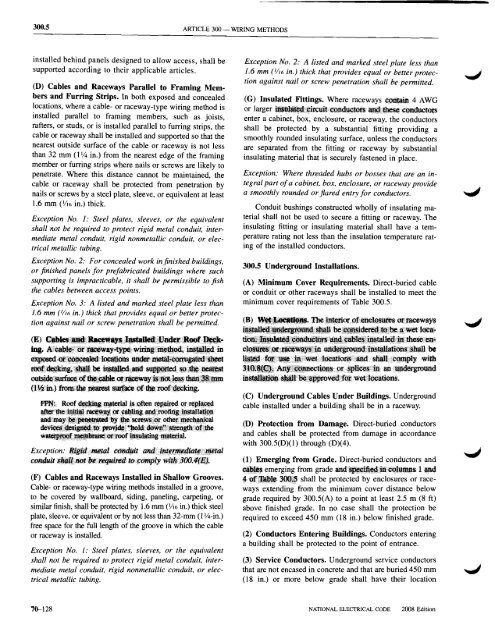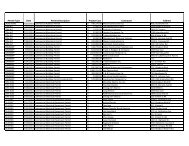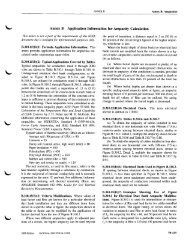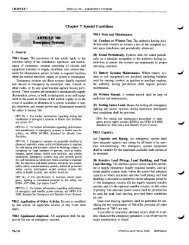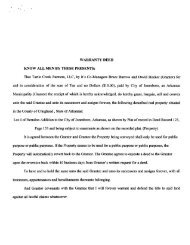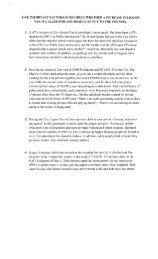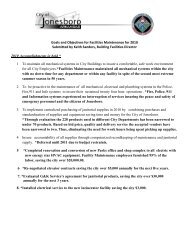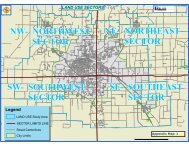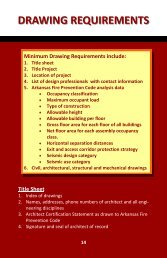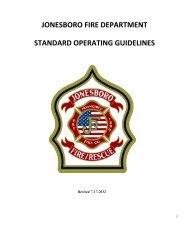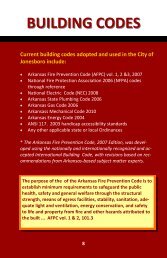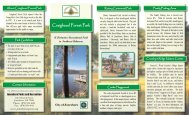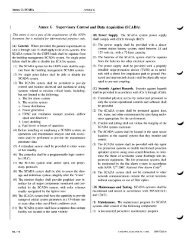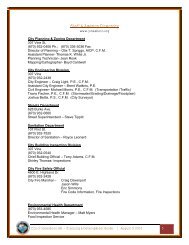Chapter 3 Wiring Methods and Materials
Chapter 3 Wiring Methods and Materials
Chapter 3 Wiring Methods and Materials
You also want an ePaper? Increase the reach of your titles
YUMPU automatically turns print PDFs into web optimized ePapers that Google loves.
300.5 ARTICLE 300 - WIRING METHODS<br />
installed behind panels designed to allow access, shall be<br />
supported according to their applicable articles.<br />
(D) Cables <strong>and</strong> Raceways Parallel to Framing Members<br />
<strong>and</strong> Furring Strips. In both exposed <strong>and</strong> concealed<br />
locations, where a cable- or raceway-type wiring method is<br />
installed parallel to framing members, such as joists,<br />
rafters, or studs, or is installed parallel to furring strips, the<br />
cable or raceway shall be installed <strong>and</strong> supported so that the<br />
nearest outside surface of the cable or raceway is not less<br />
than 32 mm (1 1 /4 in.) from the nearest edge of the framing<br />
member or furring strips where nails or screws are likely to<br />
penetrate. Where this distance cannot be maintained, the<br />
cable or raceway shall be protected from penetration by<br />
nails or screws by a steel plate, sleeve, or equivalent at least<br />
1.6 mm ('/16 in.) thick.<br />
Exception No.1: Steel plates, sleeves, or the equivalent<br />
shall not be required to protect rigid metal conduit, intermediate<br />
metal conduit, rigid nonmetallic conduit, or electrical<br />
metallic tubing.<br />
Exception No.2: For concealed work in finished buildings,<br />
or finished panels for prefabricated buildings where such<br />
supporting is impracticable, it shall be permissible to fish<br />
the cables between access points.<br />
Exception No.3: A listed <strong>and</strong> marked steel plate less than<br />
1.6 mm W16 in.) thick that provides equal or better protection<br />
against nail or screw penetration shall be permitted.<br />
(E) o.Mes~ Raee\t.~ ~Unde::r Roof ~<br />
ina. A~'~t(away.t)llt wiring;~ insW:I~in<br />
e~Qt oo~ Iotatioos uOOermetal·~sbeet<br />
rOOf~'sbd be ~tjdJ.eq.<strong>and</strong><br />
s~. so,~,~<br />
outside,swf~. of tnf,eable at'.wayW,IKlt less ~,~;1llD1<br />
(1 'h' in.) from the nearest sutfaCe of the roof decking.<br />
FPN: Roof ~g ..terial ~s,:Qften rillpaired Of repJ~ced<br />
aftfrthe in,ifial ~wa~ ,or~.lin~ <strong>and</strong>i.roofil1g instaItlltl~<br />
.':may bI:~t1;rlibe screws ,or other m,eebaniolll<br />
deviee$_~,. prl)1idif..Jtold dOWn" sU;engtkoNhe<br />
~f~ or roof Uisulllting'material.<br />
Exception: Rigid metal condilir <strong>and</strong> .intermet1ia~' metal<br />
conduit G~ll. not 1H 1WJuired to comply with 300.4fE).<br />
(F) Cables <strong>and</strong> Raceways Installed in Shallow Grooves.<br />
Cable- or raceway-type wiring methods installed in a groove,<br />
to be covered by wallboard, siding, paneling, carpeting, or<br />
similar finish, shall be protected by 1.6 mm (Y16 in.) thick steel<br />
plate, sleeve. or equivalent or by not less than 32-mm (1'i4-in.)<br />
free space for the full length of the groove in which the cable<br />
or raceway is installed.<br />
Exception No. I: Steel plates, sleeves, or the equivalent<br />
shall not be required to protect rigid metal conduit, intermediate<br />
metal conduit, rigid nonmetallic conduit, or electrical<br />
metallic tubing.<br />
Exception No.2: A listed <strong>and</strong> marked steel plate less than<br />
1.6 mm (1/16 in.) thick that provides equal or better protection<br />
against nail or screw penetration shall be permitted.<br />
(G) Insulated Fittings. Where raceways ~~ 4 AWG<br />
or larger mSttI~M::~ircuit¢'P;:nq~J0~ ~~::,t,lte~c.duetQt'S<br />
enter a cabinet, box, enclosure, or raceway, the conductors<br />
shall be protected by a substantial fitting providing a<br />
smoothly rounded insulating surface, unless the conductors<br />
are separated from the fitting or raceway by substantial<br />
insulating material that is securely fastened in place.<br />
Exception: Where threaded hubs or bosses that are an integral<br />
part ofa cabinet, box, enclosure, or raceway provide<br />
a smoothly rounded or flared entry for conductors.<br />
Conduit bushings constructed wholly of insulating material<br />
shall not be used to secure a fitting or raceway. The<br />
insulating fitting or insulating material shall have a temperature<br />
rating not less than the insulation temperature rating<br />
of the installed conductors.<br />
300.5 Underground Installations.<br />
(A) Minimum Cover Requirements. Direct-buried cable<br />
or conduit or other raceways shall be installed to meet the<br />
minimum cover requirements of Table 300.5.<br />
(C) Underground Cables Under Buildings. Underground<br />
cable installed under a building shall be in a raceway.<br />
(D) Protection from Damage. Direct-buried conductors<br />
<strong>and</strong> cables shall be protected from damage in accordance<br />
with 300.5(0)(1) through (D)(4).<br />
(1) Emerging from Grade. Direct-buried conductors <strong>and</strong><br />
~i:l1\'$ emerging from grade lUl4'i~IHU\~/iilje~lQ~s l~ftq<br />
ft.ofr•• 3~~~ shall be protected by enclosures or raceways<br />
extending from the minimum cover distance below<br />
grade required by 300.5(A) to a point at least 2.5 m (8 ft)<br />
above finished grade. In no case shall the protection be<br />
required to exceed 450 mm (18 in.) below finished grade.<br />
(2) Conductors Entering Buildings. Conductors entering<br />
a building shall be protected to the point of entrance.<br />
(3) Service Conductors. Underground service conductors<br />
that are not encased in concrete <strong>and</strong> that are buried 450 mm<br />
(18 in.) or more below grade shall have their location<br />
70-128<br />
NATIONAL ELECTRICAL CODE<br />
2008 Edition


